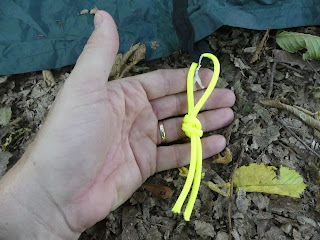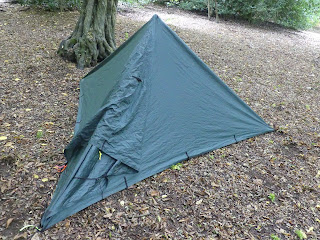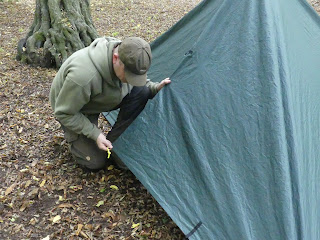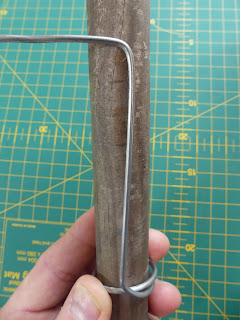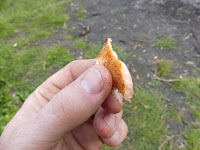Some time ago I did an article on how to ponass a trout for Scouting magazine, and more recently this technique featured in the Scout Association's Outdoor Adventure Manual which was co-produced with Haynes and featured loads of well known outdoor professionals (the Facebook page is here). Actually, despite supplying a new write up and images the original magazine article was re-used for some reason. The above right shot is me preparing the trout for the unused picture session.
So what is ponassed trout? Paul Kirtley has blogged about the history of this simple yet elegant technique and the kit needed is minimal; A hazel stick (about 3 feet in length and the diameter of a 20p coin), two smaller hazel branches about 6 inches or so in length, a knife, some string or nettle cordage, a saw and a fire.
Well I had a day off work so I decided to head down to my Scout HQ to get some practice in, and sort some dinner out at the same time (bushcrafters, want to light a fire on a whim? Have a look at this article). I used readily available shop purchased Trout (was it gutted? Yes, wouldn't you be if you'd been caught? Boom boom). As it was prepared that was one step bypassed.
After giving the knife I was going to use a good strop I got the fire started so I could build it up and allow some embers time to develop.
The preparation of the fish isn't too hard so I prepped the four sticks needed first. Fresh Hazel is a good wood of choice because it's non-toxic and splits fairly easily. Although it's usually straight this piece did have a slight bend to it, and although I could have straightened it after gently warming it over the fire, it wasn't a deal breaker. This was a three foot length which is a little long but this was on purpose because I want to cut a six inch length off the end to make a tool, but more on this later. Stand the remaining length of wood on the ground, place the knife blade in the centre of one end and gently baton the top of the blade with a stout piece of wood.
Pay close attention to the way the split is going and if it is running to one side angle the blade a little in the opposite direction. The split will need to be at least a couple of inches or so longer that the body of the fish (the distance between behind the head and just before the tail). The other pieces of wood are two thin 'kebabs'. They need to be pointed, about 5 inches in length, about 2-3mm in width and about a centimetre deep. The other is a tool to make a hole to support the Trout (a small pointy sticke) but this, along with the kebabs, are needed later.
With the of the four sections of wood prepped it's on to sorting the fish. I've got a freshly cut piece of conifer trunk but a regular chopping board or fresh bracken etc is ok too.


The first thing you need to do is make an incision at both ends, just after the head and gills, and just before the tail. The idea is to cut through the flesh al the way round but up to and not through the spine.Take care as a trout can be a slippery...Think twice, cut once.
And onto the process of parting the flesh from the bones. Note the position of my left thumb which is just sneaking under the bones which I guess are the equivalent of our ribs. Starting this off is a little fiddly but once you have got started a sweeping motion from near the spine outwards seems to work for me.
And here's a shot once I've got going which shows my thumb about the start the movement away from the spine. Slow and sure is the key because whilst the finished double fillet will look a bit rough in places you are aiming to have as little meat as possible left on the bones. Once you have worked the bones loose gently ease the spine away.
Once you have done this cut the lower fins off, not just the 'finny' bit but a small circular piece of flesh around the fin (this removes some horrid little bones). Voila, a double fillet and a head, spine and tail combo similar to the classic cartoon one.
Now before the mounting of the double fillet a word about the hole digging tool ,mentioned earlier. This, as you may recall, is the bit of the longer length that was removed. I've carved a point at the bottom end, and shaved the edges of the top end so that when you baton it into the earth to make a hole for the 'Trout pole' to sit in it won't split.
Whilst the fillet is on the preparation surface of choice make four holes at the top and bottom (in the positions shown above) and engage the kebab sticks. The top stick is a little large but it doesn't really make much difference.
Take your split length of Hazel and open the split gently whilst lowering the skewered Trout fillet into it.
The top needs securing and a green nettle, stripped of it's innards, makes a good cordage for this purpose. The nettles weren't big enough so I used some pre-soaked jute string instead. This is why a few inches extra splitting is needed.
I'll use this point in proceedings to tell you that I'm not really a fan of Trout...My late grandfather was handy with a gun and fly fishing rod and was a flipping Trout magnet and therefore I came to dislike the fish. I use a secret ingredient, namely Shwartz Season-all to pimp the flavour. At a guess it's about ninety percent salt so a little goes a long way but it is so nice with the Trout (and jacket potatoes for that matter). It is a staple for me in this outdoorsy spice holder.
I'd built the fire up with some nice seasoned pieces of Ash and a little fresh Apple wood for flavour and after making a hole with the tool fashioned earlier, I slotted in the Trout pole. Note the angle of about twenty degrees or so off the vertical. I've also got some rice on the go in a covered Crusader cup.
The cooking time is usually a few minutes depending on fire size, quality, angle etc but it's easy to check the fish is done with a little knife blade poke to check that it isn't opaque. The flesh behind the Hazel will look a little paler and wetter than the more exposed parts. Note that the Hazel pole will be rather warm when removed. To get the fish out cut the cordage and either ease it out or snap the split part carefully.
Two things happened during the pole to plate period; I had a look round our HQ grounds for edibles and found around ten different plants. I chucked some Chickweed in to the rice at the last minute to wilt. Oh, and I dropped the ponassed trout just befoe landing it on the plate, hence it's rather dishevelled look!
You can see from the bit I've pulled away the seasoned and fire facing side, and the soft lighter coloured inner flesh. The image on the right is from one of the first bushcraft courses I went on but I've noticed that they are skin side down...To be turned halfway through? To crisp up the skin? i don't recall but I will ask the question.
I've also used this setup to cook bacon over the skewer parts, and it can be scaled up to accommodate a Salmon, as John Rhyder has done in this image. Find out why we has done this for the Scout Association here.

